The Danger of Deafness
By H Dominic W Stiles, on 24 May 2019
 Close
Close
Information on the UCL Ear Institute & Action on Hearing Loss Libraries

By H Dominic W Stiles, on 24 May 2019
By H Dominic W Stiles, on 17 May 2019
An American Deaf man of the late 19th century, Marcus Hill Kerr was born in Liberty Township, Jackson, Michigan, in 1845. His father Robert was a farmer with at least eight children, and as the town was settled in 1835, the Kerr family must have been one of the first in the district. When he was three he suffered from ‘brain fever’ and lost his hearing as a result. When he was twelve he was sent to Flint, to the Michigan School for the Deaf, and he graduated from there in 1865 (Gallaher, p.142, from which much of what follows comes, and Obituary). Kerr went on to study at Gallaudet, to what level I cannot say – Gallaher says merely he ‘spent some time’ there.
His artistic talent was evident as a child – for example, he drew ‘an Indian shooting an elephant on a small wooden box’! The article in Representative Deaf Persons of the United States of America seems to have been from interview with Kerr, and we have a few particular details of his early life, such as that he would read newspapers at the local ‘news depot’ but as he could not afford to buy them, he would draw pictures from memory afterwards.
Marcus’s first oil painting was painted when he was thirteen and was of his old shepherd dog. He also made landscapes and portraits, ‘for a living’ before going to Rochester, New York, to study under a ‘celebrated artist’ Professor Adam Springfield.* Before that he had been entirely self-taught. Kerr went on to the artists’ colony in New York we are told, and then travelled to Europe in 1871, including visits to London, Düsseldorf and Paris. The article says he ‘studied’ in these places. Probably that means he was studying under his own steam, and we may wonder how long he was studying with the celebrated Professor. Springfield was a witness to Kerr’s passport application, in September 1872 – was he going abroad then, after getting married, rather than in 1871? That would be an area for further research.
In September 1871, he married a Deaf lady from Jackson, called Adele George (1834-1921), nine years his senior, but who had also been at the Michigan School. His obituary does not mention her, but does say he lived at the corner of Elm street and Main. Adele is herself really interesting, and if you can you should read the article on her by Seitz and Laffrado cited below. She was a poor Deaf woman who found her voice, writing and publishing her life story, A brief narrative of the life of Miss Adele M. George: (being deaf and dumb) in a number of different editions over many years, from 1859, then selling sufficient copies to rescue herself and her mother from homelessness.
Adele married a cousin, Harrison Jewell, and they had three children including a Deaf son who went to the Michigan School but died aged sixteen. They were divorced, and then Adele married Marcus Kerr. The marriage was not successful in the long run, and they had to endure the loss of three children in infancy. Their divorce in 1890 was reported in the newspapers, as Kerr was well known, though Adele (Adell) is described in the city directory for Jackson in 1899 and also in 1902, as ‘Kerr, Adelle (wid Marcus H) bds 736 S Milwaukee’ – in other words she was calling herself a widow before Marcus died (Seitz and Lallrado p.174). Kerr had accused Adele of “extravagance and desertion” (ibid.). we might wonder what blame he carried – he did not wait about, marrying another deaf lady, Mamie E. Nettleton of Indiana, in January 1891.**
Kerr spent his later years in St. Louis, moving there in 1885, painting the ex-mayor Walbridge, as well as a pastel of the Rev. Thomas Hopkins Gallaudet, which was exhibited at the World’s Fair in Chicago in 1893, and was presented to the college. He also painted Helen Keller and Alexander Graham Bell. Do these portraits survive?
The most bizarre thing about Marcus Kerr, is his entry in Peeps into the Deaf World, where we discover that he trained a pug to perform various tricks. It was this picture that got me looking into his life. Whether this was a pastime or perhaps an additional source of income I do not know. I am sure there is more to discover. His end was sad, and a fate shared by many deaf people over the years. He was knocked over when crossing a road on the 10th of April, 1903, by a car he did not of course hear.
Mamie is pretty opaque in the records – at least after a brief search I have not been able to pin her down, neither have I found Kerr on the 1900 census, but I have little time to look. Did their marriage last, or did she die? In his obituary she is not named. That obituary, in the Jackson Citizen, quoting the St. Louis Post and Dispatch, says he had a studio at 3837 Delmar Avenue (see article on Find a Grave in the link below).
 *Someone I have not been able to track down in the brief time available to research this blog in any detail, but have found this romantic Victorian historical painting by him.
*Someone I have not been able to track down in the brief time available to research this blog in any detail, but have found this romantic Victorian historical painting by him.
Gallaher, James E., Representative Deaf Persons of the United States of America, 1898 (2nd ed.) p.142-3
Roe, W.R., Peeps into the Deaf World, 1917 p.290-1
The St. Louis Republic. (St. Louis, Mo.), 11 April 1903. Chronicling America: Historic American Newspapers. Lib. of Congress. <https://chroniclingamerica.loc.gov/lccn/sn84020274/1903-04-11/ed-1/seq-3/>
Seitz, Rush, and Laffrado, Laura, Adele M. George Jewel Kerr (1834–?), Legacy Vol. 30, No. 1, Special Issue: Women Writing Disability (2013), pp. 172-183
US Census returns
Year: 1850; Census Place: Liberty, Jackson, Michigan; Roll: M432_352; Page: 402A; Image: 556
Year: 1880; Census Place: Jackson, Jackson, Michigan; Roll: 585; Page: 424D; Enumeration District: 123
U.S. Special Census on Deaf Family Marriages and Hearing Relatives, 1888-1895
Passport Record – National Archives and Records Administration (NARA); Washington D.C.; Roll #: 187; Volume #: Roll 187 – 01 Aug 1872-30 Sep 1872
Ancestry.com. U.S. City Directories, 1822-1995 [database on-line]
By H Dominic W Stiles, on 3 May 2019
Arthur Wellesley, the Duke of Wellington, who was born 250 years ago, in 1769, suffered from noise-related hearing loss caused by artillery. William Wright tells us,
The Duke of Wellington was inspecting an experimental carriage for a howitzers and whilst in advance of the gun, gave the word ” Fire ;” the result was the rupture of the membrane of the drum of the left ear. The Duke went immediately to Mr. Stevenson who told his Grace the story, about thickening the drum of the ear. The solution of caustic was applied; instant pain ensued, from the caustic passing through the ruptured membrane amongst the ossicula, and very sensitive internal tissues. Within six hours the Duke was conveyed home from Lord Liverpool’s, in a state of insensibility, and it was only by most careful, skilful treatment that his life was then preserved. He went to Verona, a great sufferer, and the country had very properly to make a handsome compensation to Dr. Hume, and his family, for giving up his practice to attend the Duke on his mission. (Wright, 1860, p.75-6)
Graham Smelt says that this was on On August the 5th, 1822. His hearing loss was made considerably worse by the botched treatment, a story related by a Mr Gleig, in an anecdote that suggests it was Hume who was to blame –
The Duke, many years ago, being deaf, sent for his medical man, who poured some stuff into his ear, not knowing that the drum of the ear was broken. This proved very mischievous in its results. The Duke said it was not sound that was restored to him; it was something terrifically beyond sound: the noise of a carriage passing under his window was like the rolling of thunder. Thus suffering, he returned home about the middle of the day, and went to bed. Next day, Dr. Hume called and found the Duke staggering about the room. Dr. Hume, although he well knew the Duke’s temperate habits, supposed that he had taken a little too much wine overnight, and had not recovered from it. He was leaving the room, when the Duke said to him : Hume, I wish you would look to my ear ; there is something wrong there.’ Hume looked and saw that a furious inflammation had begun, extending to the brain ; another hour, and the stuff would have done for the Duke what all his enemies had failed to do : it would have killed him. Hume bled him copiously, sent for Sir Henry Halford and Sir Astley Cooper, who treated him with great skill, and brought him round. The poor man came next day and expressed his great regret. The Duke spoke to him in his kindest manner and said, I know you did not mean to harm me ; you did your best, but I am very deaf.’ Upon which, the Doctor said, I am very sorry for it ; but my whole professional prospects are at stake, and if the world hears of it I shall be ruined.’ ‘The world need not hear at all about it,’ said the Duke; ‘keep your counsel, and I’ll keep mine.’ The Doctor, encouraged by this, went a little further : Will you let me attend you still, and let the world suppose that you still have confidence in me ?’ ‘No, no,’ said the Duke, ‘I cannot do that ; that would not be truthful.’ (Davies, 1854 p.16-17)
 To me this sounds like a well-rehearsed anecdote, but there is something ‘missing,’ it seems to me, in Wright’s account, in that he seems to imply that Hume had some hand in the affair without explicitly saying so. Or is he just omitting Stevenson’s name, and ‘the poor man’ is Stevenson? Smelt says that Stevenson was to blame, and that Hume treated him afterwards. In an earlier book, Wright tells us –
To me this sounds like a well-rehearsed anecdote, but there is something ‘missing,’ it seems to me, in Wright’s account, in that he seems to imply that Hume had some hand in the affair without explicitly saying so. Or is he just omitting Stevenson’s name, and ‘the poor man’ is Stevenson? Smelt says that Stevenson was to blame, and that Hume treated him afterwards. In an earlier book, Wright tells us –
Deleau states that he can reach the cavity of the tympanum by a bent probe, or catheter. If he even can do so, which I consider is very problematical, I am convinced the operation is attended with considerable danger, for the ossicula (the small bones) which extend from the inside of the membrana tympani, to the opposite side of the cavity, would be in great danger of being forced from the situation in which Providence has been pleased to place them, or their functions would be otherwise diminished, or destroyed, and such would be the effect of any injury being inflicted on this delicate organization, that inflammation of the brain, and even death, would be a probable consequence. An example of this was unfortunately nearly afforded about the end of 1822, or beginning of 1823, in the case of the Duke of Wellington, a lotion of lunar caustic had been dropped into the external auditory passage, there was an opening at the time through the membrane (or drum), from an accidental cause, and the caustic lotion entered the cavity beneath, containing the highly sensative [sic] integuments, and machinery therein placed ; the results were intense pain; in a few hours inflammation of the brain, with symptomatic fever, and his life was only preserved by the most prompt and efficient treatment pursued by his Physician, aided by other medical and surgical advice derived from the first men of the age. In June, 1823, I was called into attendance on his Grace, as his aurist, and continue still to attend him when necessary ; even at this distant period from the unfortunate occurrence, the Duke feels sufficient unpleasant effects occasionally, not to allow him to forget it, independent of the privation of his left ear.* Similar, if not even worse, must necessarily be the consequence of introducing an instrument into the cavity of the tympanum, even if the patient be in a state of health; but if there exist any tendency to inflammatory action, scrofula, or erysipelas, the danger is increased, and the disastrous effects, or even fatal termination of the experiment, for it is nothing more in ninety-nine cases out of a hundred, unavoidable. (Wright, 1839, p.55-7)
* In pp. 159 and 160, of “An Exposition of Quackery and Imposture in Medicine,” written by Dr. Caleb Ticknor, of New York, republished in this country, which I edited, and upon which I wrote copious notes, will be found a further account of the Duke of Wellington’s case.
Note how free doctors were then with patient information, while the patient was still alive. Smelt suggests as well as the seriously damaged ear, he also had noise-induced hearing loss in his other ear as he got older.
In 1852 the Duke wrote in a letter,
I have none of the infirmities of old age I excepting Vanity perhaps. But that is a disease of the mind, not of the Body ! My deafness is accidental ! If I was not deaf, I really believe that there is not a youth in London who could enjoy the world more than myself or could bear fatigue better, but being deaf, the spirit, not the body, tires. One gets bored, in boring others, and one becomes too happy to get home. (Wellington, 1854, p.314-5)
Losing his hearing had other consequences, as we see from this on February 20th, 1848 from the Greville memoirs –
At the House of Lords on Friday night, for the Committee on the Diplomatic Bill. Government beaten by three, and all by bad management ; several who ought to have been there, and might easily have been brought up, were absent : the Duke of Bedford, Duke of Devonshire, Lord Petre, a Catholic, dawdling at Brighton, and Beauvale. The Duke of Wellington, with his deafness, got into a complete confusion, and at the last moment voted against Government. (Greville, 1888, p.129)
When he was in his eighties, as members of Derby’s 1852 government were announced, the now quite deaf Duke kept repeating, “Who? Who?” It became known as the “Who? Who?” ministry.
Davies, George Jennings, The completeness of the late duke of Wellington as a national character, 1854
Greville, Charles Cavendish Fulke, The Greville Memoirs: A Journal of the Reigns of King George IV, King … 1888
Hazlitt, William, ed, Arthur Wellesley Duke of Wellington, The Speeches of the Duke of Wellington in Parliament, Volume 2, 1854
Smelt, Graham, Wellington’s Deafness. Abstract presented at the meeting British Society for the History of ENT, Held December 1st 2011 In the Toynbee McKenzie Room, at the Royal Society of Medicine, London
Wright, William, A few minutes’ advice to deaf persons…, 1839
Wright, William, On the varieties of deafness and diseases of the ear, 1829
Wright, William, Deafness and Diseases of the Ear: The Fallacies of Present Treatment Exposed … 18
By H Dominic W Stiles, on 26 April 2019
Kathleen Trousdell Shaw was born in Edmonton, Middlesex, in 1865, daughter of a doctor Alfred Shaw, who was at the time working in London. According to her the Silent World article, she was brought up in Ireland, where the family was from, when she was a child. The story related in that article, is that when she was nine she was ‘enthralled’ watching a stonemason carve the lettering for her grandmother’s tombstone in the churchyard (where it does not say), and the mason gave her some stone and two chisels so that she could try carving herself. Her talent was sufficiently remarkable that she was sent to Dublin Art School aged ten. The article on her from Freeman’s Journal, says, “There is a gruesome poetry about the picture, a tiny soft-lipped child stands by and gravely watches a man engaged upon work of the significance of which she is utterly unconscious.”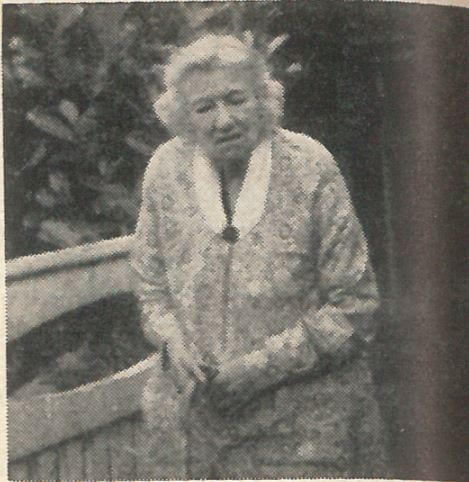
She gained medals and prizes and when fifteen years old managed to collect £25 with which she went to Paris and joined her elder sister in a tiny flat in the Quartier Latin. To her great joy she was accepted as a student at the Ecole des Beaux Arts, where there were no fees, and where she could study under the most eminent French artists and sculptors.
At seventeen she returned to Dublin where she did a few portrait busts, including one of Prince Edward of Saxe-Weimar, but before long she was travelling again, having won a scholar-ship of £200 for two years. This enabled her to carry out her ambition of going to Rome where she attended the studio of M. Charles Desvergne and led a pleasant life among the artists and critics, besides meeting young people of her own age at parties and dances.
[…] From the age of thirty she was stone deaf. She returned for a time to London, and worked in Julian’s studio and in the British Museum, when she got the chance of going to Athens with her friend, Miss Venning.* They went in a French ship and she made a medallion portrait of the French captain which delighted the sailors. ‘C’est lui-meme,’ they said, ‘It is he himself’.
In Athens the British Ambassador befriended them and used to take them out in his yacht to visit some of the beautiful islands, and Miss Shaw did several portraits of diplomats and some of lovely Greek children. When she returned to England she lived for a time at Knutsford in Cheshire, doing portrait busts both in bronze and marble and exhibiting in the Royal Academy. One of the Duchess of Buckingham in marble was specially admired. Later in London she made busts of Lord Avebury, the beautiful Countess Annesley and many distinguished people, which were exhibited at the Royal Academy and in the Paris Salon. […]
Her work was recognized and honoured when she was made a Member of the Royal Hibernian Academy in 1907. She was the first woman sculptor to be made a member of any Royal Academy in the British Isles. (James, p.266-7)
According to the 1901 census, Shaw saw at that time living in York Street Chamber, Marylebone, a near neighbour being Rosamond Venning. These chambers were “The York Street Chambers were built in 1892 to house single professional women and the tenants were principally artists, authors, nurses.” It would possibly be useful to anyone trying to uncover more about Shaw, to have a look at what records survive – it might for example tell us how long she was there.
It seems that Venning was involved in the suffrage movement as can be seen from a letter in the Women’s Library Archive. By the time of the 1911 census, they were living together in 13 Belsize Park Gardens, and Shaw is described as Venning’s adopted daughter. Their friendship must have begun much earlier, for the article says ‘until she was thirty she could just hear the voices of two people, her mother and her friend Miss Rosamund [sic] Venning’ (p.266). As she made a relief of Venning in 1892, they must have been acquainted at least no later than that.
She lived with Rosamond at Pitt Cottage, Cadmore End, Buckinghamshire, in the 1920s, during which period she lost her sight, and when Rosamond died she left her estate to Kathleen.
Kathleen Shaw died on the 30th of June, 1958, in Amersham Hospital.
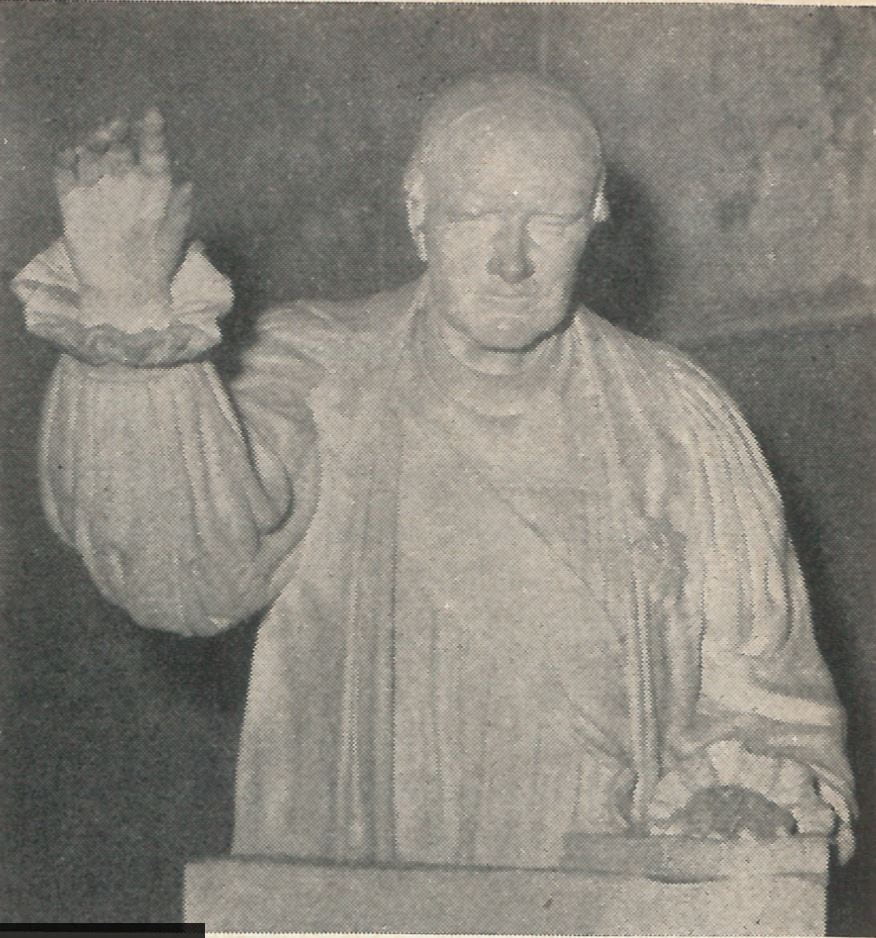 Among her work is the bust of Archbishop Alexander, husband of the Deaf hymn-writer, Fanny Alexander, in Armagh Cathedral, and the Armagh war memorial. A war memorial font cover in Cadmore Church, with a silver figure, was made with gifts of silver from villagers. Also, she made a monument to two Venning ancestors at Totnes.
Among her work is the bust of Archbishop Alexander, husband of the Deaf hymn-writer, Fanny Alexander, in Armagh Cathedral, and the Armagh war memorial. A war memorial font cover in Cadmore Church, with a silver figure, was made with gifts of silver from villagers. Also, she made a monument to two Venning ancestors at Totnes.
How tragic that blindness cut short her career.
This reference gives a long list of here work –
*Venning seems to have been an antiquarian – see https://archive.org/stream/annualreportamern115amer/annualreportamern115amer_djvu.txt and also https://en.wikisource.org/wiki/Page:Folk-lore_-_A_Quarterly_Review._Volume_5,_1894.djvu/366.
James, The Honorable Mrs. B.R., Kathleen Trousdell Shaw, Silent World, 1954, p.266-7
1901 Census – Class: RG13; Piece: 111; Folio: 158; Page: 39
1911 Census – Class: RG14; Piece: 609
Ancestry.com. Ireland, Select Marriages, 1619-1898 [database on-line].
Freeman’s Journal – Tuesday 01 May 1894, p.6
Pall Mall Gazette – Saturday 06 April 1895, p.3
Villagers Humble Gifts, Yorkshire Evening Post – Saturday 24 April 1920 p. 6
Western Times – Monday 14 April 1902, p.2
By H Dominic W Stiles, on 16 April 2019
Doris Florence Morgan was born in Acton on the 13th of August, 1906, daughter of a ‘glove cleaner’ (later a dry cleaner) Henry Morgan, and his wife, Florence. The 1911 census, at which time they were living at 34 Goldsmith Road, Acton, tells us she was ‘deaf and dumb from birth.’ George William Munday was born in 1905, son a Albert (a cabman) and Annie Isabella. The 1911 census tells us that he was ‘deaf and dumb from 1 year.’ The two were married in April, 1933.
This story is simply told as all I have apart from this information, what I have is two newspaper clippings with Selwyn Oxley’s inimitable scrawl, which tell the sad story:
WEDDING PARTY AT A BRIDE’S CREMATION
Forty people who were guests at the wedding, ten days ago, of a London deaf and dumb girl, will reassemble on Saturday at Golders Green, N.W., when the young bride is to be cremated—in her bridal gown.The girl, Doris Morgan, of Mansell-road, Acton, W., married George Mundy, of Hendon, N.W., also a deaf mute.
After a short honeymoon at Hastings, they returned to their new home last Saturday. On Sunday she was taken ill and became unconscious. She died next morning without recovering consciousness.
“She was a bright girl, strong and capable at her work,” said her father last night. “She was the last person one would have thought would meet with so sudden a death.” (Daily Herald, 20/4/1933)
A second report says –
Wedding March at a Funeral
DEAF AND DUMB BRIDE CREMATED IN WEDDING DRESS
Mendelssohn’s Wedding March was played by the organist and the funeral service was translated into the deaf and dumb language at the cremation at Golders Green to-day of Mrs. Doris Florence Munday, aged 26, of Mansell-road, Acton, W., the deaf and dumb bride who died nine days after her marriage.Her husband, who is also deaf and dumb, attended the service with friends who were at the wedding. The dead woman was cremated in her bridal clothes in a white coffin.
The Rev. Herbert Trundle, chaplain of the Crematorium, read the service aloud which was interpreted in the deaf and dumb language by the Rev. H. M. Ainger, assistant chaplain to the Royal Society of the Deaf and Dumb, who officiated at the wedding of the couple a fortnight ago. (Evening Standard, 21/4/1933)
1911 Census (Morgan) – Class: RG14; Piece: 6958; Schedule Number: 493
1911 Census (Munday) – Class: RG14; Piece: 7109; Schedule Number: 286
By H Dominic W Stiles, on 12 April 2019
Having previously covered Mary Chapman and her missionary deaf school work in south Asia, we recently mentioned her Jerusalem school in relation to the beginnings of Israeli Sign Language. Chapman raised funds through the “Thankful Hearts League” to found a mission school for the Deaf in Jerusalem, and started the school in 1931 according to Höxter (p.118). He continues,
Until now it has had but few pupils, mostly native Arab children, who receive their instruction in the English language from the directress in a small congenially arranged dwelling house. The school has a homelike atmosphere; the lovable directress cares for her small charges with affection and devotion. She has taught the deaf for thirty years in many lands. One of her former pupils from Burma instructs the children in manual training and drawing. With the younger children the method of instruction depends mainly upon observational activity, seeking to direct attention to training in lip-reading. Speech instruction is carried on by the single-sound method. The school should grow in the near future.
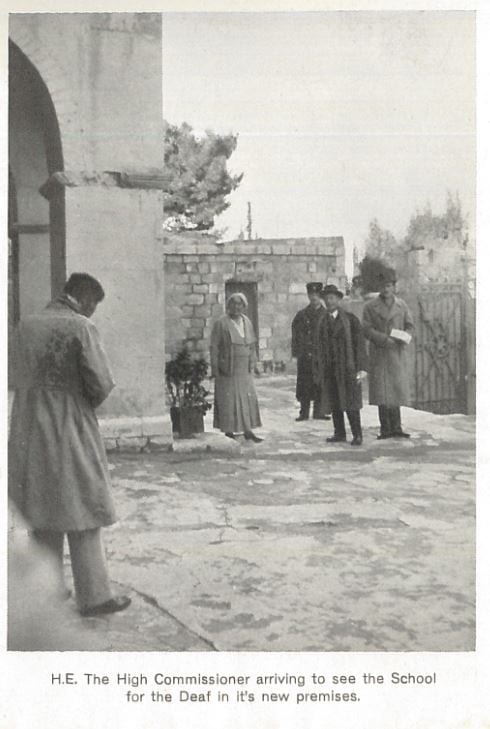 Chapman had the help of her long-time colleague Miss Martin, and the Burmese Deaf young man, Bolo. She appears to have written regular newsletters to her Thankful Hearts League supporters in the U.K., and they must have assisted with both money and material items such as clothes. In 1937 the school had a visit for Sir Arthur Wauchope the High Commissioner, who gave £10 for the school.
Chapman had the help of her long-time colleague Miss Martin, and the Burmese Deaf young man, Bolo. She appears to have written regular newsletters to her Thankful Hearts League supporters in the U.K., and they must have assisted with both money and material items such as clothes. In 1937 the school had a visit for Sir Arthur Wauchope the High Commissioner, who gave £10 for the school.
The school taught the boys with lipreading, and they learnt to lipread both English and Arabic. She says in the 1938 newsletter, “There are some sounds in Arabic which seem almost impossible to lip read, or to get a born deaf child to say, but we are persevering !!!”

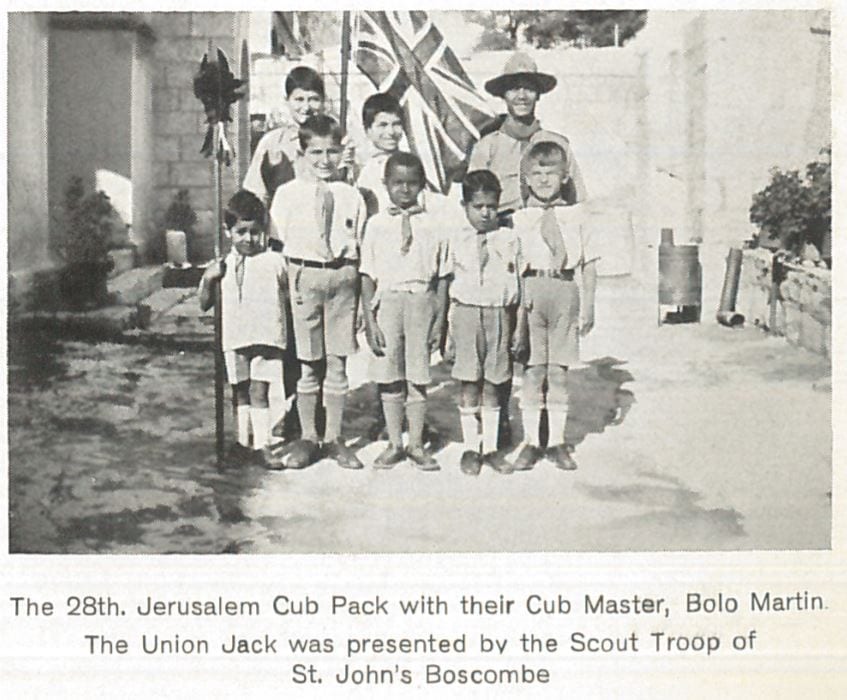 Further on she tells us this story –
Further on she tells us this story –
Two of the Sergt. Majors came to our help one Sunday morning, when a Moslem man brought his little son to our School. The Matron of the Government Hospital most kindly said she would take the boy, give him a carbolic bath, and get the Doctor to examine him, before we admitted him to school. Miss Walden and I were so relieved, as we were alone with the boys, all the others having gone to Church, but our joy was short lived, for the telephone went, and the Matron said she was sending Ally back, as his screams, and kicks were frightening all the patients, many of whom were seriously ill. We knew that once the father had left, Ally would settle down happily with the other boys, so I went next door, and these two Sergt. Majors gladly came in, took the boy from his father, and gave him a bath. The Matron sent an Arab policeman from the hospital to help the father bring the boy back to school, for the poor man could do nothing with his son, and he is only seven years old . The policeman asked to see the school, and was amazed to see such a happy well behaved number of deaf and dumb boys!! and great was his astonishment when the boys spoke to him in Arabic, and answered the questions he asked them ; he went away saying “This is a wonderful place, here little devils are turned into angels”.
 The school was still going in 1948, as Miss Mary F. Chapman’s School for the Deaf and Dumb, at 135 St. Paul’s Road, Jerusalem. I wonder if the school closed with the crisis that saw war in Palestine and the creation of the state of Israel? If you have any information, please add it below. I include the 1937 newsletter as a picture, and the 1938 one as a pdf. If there are other newsletters surviving, it would be nice to know.
The school was still going in 1948, as Miss Mary F. Chapman’s School for the Deaf and Dumb, at 135 St. Paul’s Road, Jerusalem. I wonder if the school closed with the crisis that saw war in Palestine and the creation of the state of Israel? If you have any information, please add it below. I include the 1937 newsletter as a picture, and the 1938 one as a pdf. If there are other newsletters surviving, it would be nice to know.
As usual, click onto smaller images for a larger size view.

Höxter, Richard, The Deaf and Provision for Their Education in Palestine. American Annals of the Deaf Vol. 82, No. 2 (March, 1937), pp. 117-121
By H Dominic W Stiles, on 29 March 2019
According to Meir and Sandler’s 2008 book, A Language in Space: the Story of Israeli Sign Language (p.185), we know nothing of the signs used by deaf people, Jewish or Arabic, in the late Ottoman period in Jerusalem. Persecution in Europe in the 1930s saw immigration into British mandated Palestine, and an early Deaf immigrant was Moshe Bamberger, who arrived in Jerusalem in 1935 (ibid). A ‘Jewish School for Deaf Mutes’ had been established there in November, 1932, with the backing of a Jewish man from Shanghai who had lost his hearing, and a teacher from the Jewish Deaf School in Berlin was appointed as head.
The Jewish school for the deaf, which has the major part in the education of the deaf in Palestine, was called into being mainly by the efforts of the otologist, Dr. Marcus Salzberger, who soon after his settling in Palestine (1923) conceived the plan to establish such a school. As funds were necessary for such an undertaking, the carrying out of plan took several years. He found in Miss Jessie Samter of Rechowoth, near Tel-Aviv, a valuable aid who succeeded in procuring some funds from America. To manage the school they found an instructor who professed to have had training in Poland to teach the deaf. Under these auspices there was opened in 1930 in Tel-Aviv the first Jewish school for the deaf in Palestine, an enterprise which lasted for two years. In the year 1929 there died in Shanghai one Leone A. Levy, who at the age of thirty had become deaf. He left his fortune to the Alliance Israélite Universelle with the request that a school for the deaf be established in a Jewish center. Dr. Salzberger went to Paris and prevailed upon Professor Sylvain Levy, the then president of the Alliance, to found the school in Jerusalem under the direction of a specialist in the education of the deaf from Germany, the present director. It was opened in November 1932 with two pupils. (Höxter, p.118-9)
The influence of German sign Language (DSL) was important on the development of Israeli sign Language. Bamberger met two other Deaf people in Jerusalem, Aryeh Zuckerman, who had also been a pupil at the Berlin School at Weissensee, and a local man, Yehezkel Sella, and they formed the nucleus of the Jewish deaf community in Jerusalem (Meir and Sandler, p.186). Although the Jerusalem school was oralist at first, it seems that when they could the children naturally used sign language (ibid p.198). With contributions from immigrants from different places in Europe and native Deaf people, Israeli sign language had a mixed origin, which makes it interesting as a subject for linguists to study.
We have a document from 1969 by J. Shunary, attached below, which is a brief history of the formation of Israeli sign Language. One of the sources was Zillah Farkash. Neither of those people is mentioned in the index of Meir and Sandler, so perhaps they did not have this document. Shunary says,
it is very difficult to determine which of the original German signs did in fact displace local signs, and which were rejected by the local deaf population as being unsuitable. (For example, one source claims that the signs “not good,” “Jew,” and. “English” were discarded.) Usually the Germen signs, described by one veteran as highly flexible and refined, were accepted as being in accordance with the character of locally used signs. It in therefore probable that there was a process of mutual interaction between local and imported signs, with a resulting trend towards increased refinement and stylization [sic] of newly created signs.
At the end of the 1930’s and in the early 1940’s members of the deaf association customarily met on the Tel Aviv seashore and in a certain cafe on the main road, or in private homes. Although many were illiterate or poorly informed and were not able to obtain much information from the usual channels, this lack did not prevent them from playing important roles in the forming society. The home of three members served as a central meeting place. A central social role was also played by another member, a tailor of limited means. Although illiterate, he was an outstandingly warm host and his house was always crowded with visitors. Another focal meeting place was the home of “Educated” Egyptian-born brother and sister who had recently immigrated from France. Conversation at meetings concerned everyday affairs, work, current events, films they had seen, jokes mimed by a few members with considerable pantomimic talent and a good sense of humor, and naturally, plain gossip too. News items were related to those who were illiterate by the “Educated.” At that time group games as they are played. today were not the custom. However, the Europeans used to invent sketches, and programs were performed for special occasions, religious festivals, etc. A member who was hard of hearing served for some time as producer of these sketches. (Shunary, p.2)
There was also a French Convent School, St. Vincent, of which Höxter says, “In the convent school, deaf, blind and crippled children are under the care and instruction of French nuns. The number of deaf children and the method of instruction are unknown to the writer of this paper, as no visitors are admitted to this convent school.” (p.117)
The third school, was that run by Mary F. Chapman who I have written about with regard to her mission work in Ceylon and Burma. I will come back to that school in a future post.
A Pioneer again goes pioneering. Further work for the deaf and dumb in Palestine. British Deaf Times 1931, p.75
Höxter, Richard, The Deaf and Provision for Their Education in Palestine. American Annals of the Deaf Vol. 82, No. 2 (March, 1937), pp. 117-121
https://en.wikipedia.org/wiki/Israeli_Sign_Language
Meir, Irit, and Sandler, Wendy, (2008) A Language in Space: the Story of Israeli Sign Language. Chapter 11, The History of the Deaf Community in Israel p.185-216
Shunary, J., (1969), Social Background of the Israeli Sign Language
By H Dominic W Stiles, on 15 March 2019

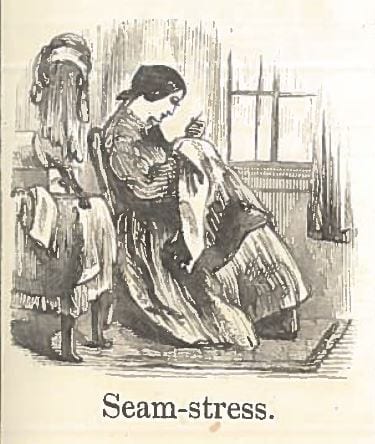 Mary Ann Frances Burnell was born in Cosgrove, Northamptonshire, in 1857, daughter of a labourer, William Burnell (aslo Burnal) and his wife, Elizabeth. She was not described as deaf in the 1861 census when she was three, but a later census says she was ‘deaf from birth’ (1891). She had at least one hearing brother and sister surviving, but many more that died very young.
Mary Ann Frances Burnell was born in Cosgrove, Northamptonshire, in 1857, daughter of a labourer, William Burnell (aslo Burnal) and his wife, Elizabeth. She was not described as deaf in the 1861 census when she was three, but a later census says she was ‘deaf from birth’ (1891). She had at least one hearing brother and sister surviving, but many more that died very young.
This beautifully done sampler was made by her when she was a pupil at Edgbaston School, which she entered aged 9 in 1867, and left in 1873. It says,
How doth the little busy bee
Improve each shining hour
And gather honey all the day
From every opening flower
Mary Ann Frances Burnell
Aged 14 years 1870
Deaf and Dumb School
Edgbaston
It may not surprise you to know that she became a lace-maker – Northamptonshire being famous for its lace at that time. In the 1881 census she was living with her parents in Cosgrove. By the late 19th century however, modern materials and methods of mass manufacture had ruined the old lace-making trade, and she and her mother were working as laundresses, a very tough job. Mary died in Oxfordshire, in 1947, never having married. 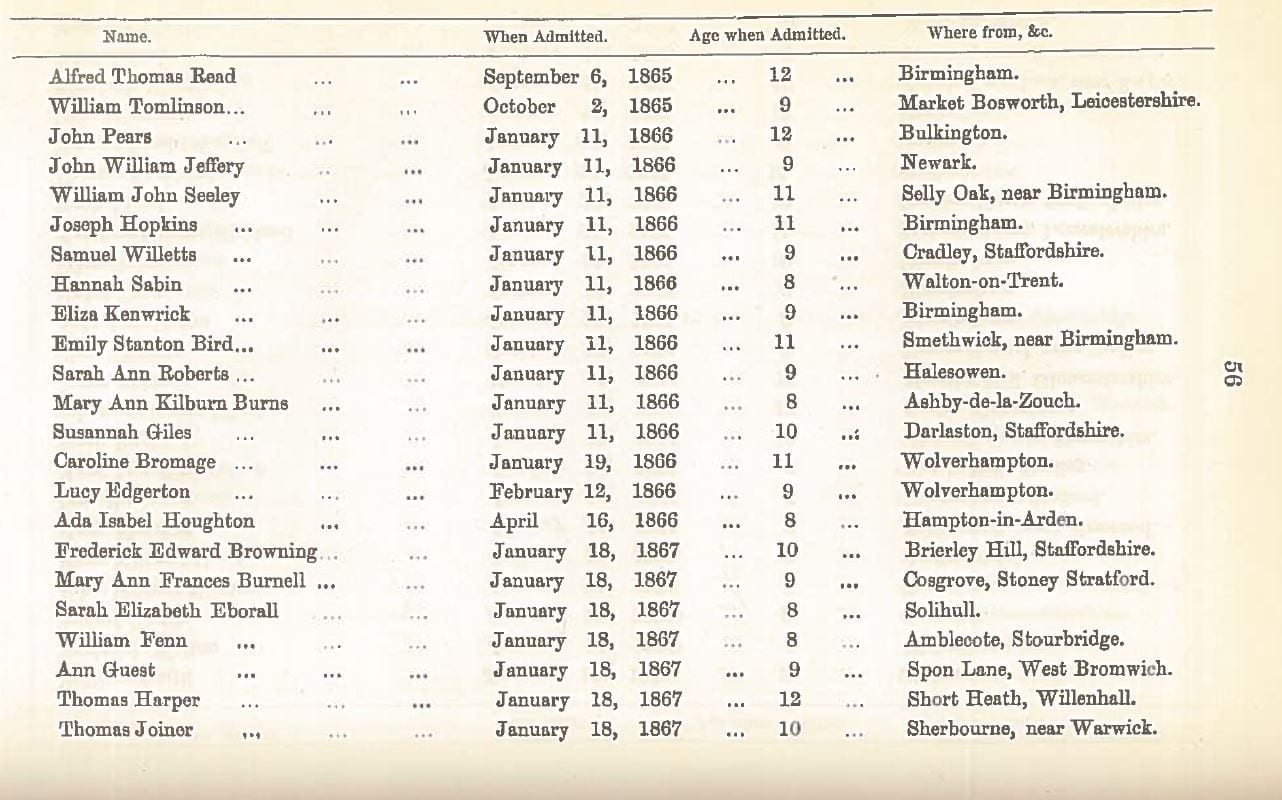
I wonder if the sampler came to us via Selwyn Oxley. He went on several mission trips to Oxfordshire and worked there in some capacity for a while on a voluntary basis.
On the left is a list of some of the pupils in the school in 1872. Click onto the image for a larger size. It is possible that we could find her in some of the mission news, but it seems likely that as an adult she was the only Deaf person in her immediate area, and she lived in a village rather than a town where she might have had the company of other Deaf people as she had at school.
The Embroidery & Seamstress pictures come from the 1857 book, An Illustrated Vocabulary Prepared for the use of the Deaf and Dumb.
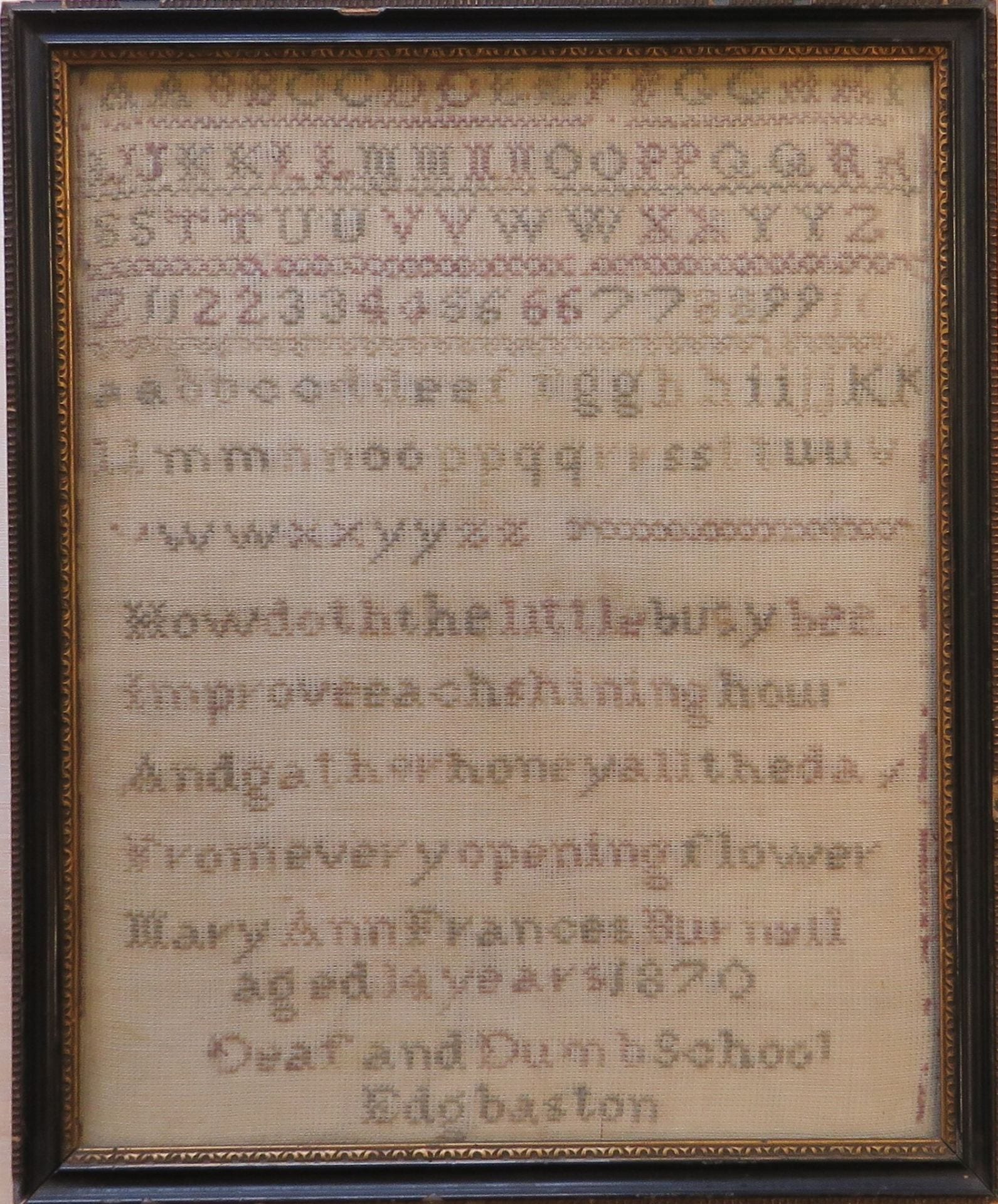 1861 Census – Class: RG 9; Piece: 927; Folio: 29; Page: 16; GSU roll: 542722
1861 Census – Class: RG 9; Piece: 927; Folio: 29; Page: 16; GSU roll: 542722
1881 Census – Class: RG11; Piece: 1537; Folio: 28; Page: 13; GSU roll: 1341370
1891 Census – Class: RG12; Piece: 1189; Folio: 20; Page: 7
1901 Census – Class: RG13; Piece: 1413; Folio: 25; Page: 13
1911 Census – Class: RG14; Piece: 8351; Schedule Number: 79
Free BMD Deaths Mar 1947 Burnell, Mary A F aged 89 Oxford 6b 1242
By H Dominic W Stiles, on 8 February 2019
 Arthur MacDonald Cuttell, (1869-1904), was an editor of Ephphatha and then later of the British Deaf Mute. Born in Cornwall, son of the Rev. A.W. Cuttell of Margate, he became deaf through scarlet fever when he was nine. He was educated at Helston Grammar School, then later in Matlock, Derbyshire. He was apprenticed at the Crown Derby Works, where he became an artist decorating ceramics.
Arthur MacDonald Cuttell, (1869-1904), was an editor of Ephphatha and then later of the British Deaf Mute. Born in Cornwall, son of the Rev. A.W. Cuttell of Margate, he became deaf through scarlet fever when he was nine. He was educated at Helston Grammar School, then later in Matlock, Derbyshire. He was apprenticed at the Crown Derby Works, where he became an artist decorating ceramics.
It was whilst at Derby Mr. Cuttell’s attention seems to have been drawn to work upon behalf of the deaf and dumb, and, leaving an artistic career, he entered the Derby Institution for the Deaf, and for a time worked as a teacher under Dr. Roe. He also undertook mission work amongst the adult deaf of Derby. Leaving Derby, he went to Newcastle-upon-Tyne, and, during the illness of the Rev. W. W. Adamson, acted as missioner to the deaf of that city and district. In 1897 he was appointed missioner to the deaf of Leicester and county, and upon their behalf he laboured until his death. (Obituary)
In Gilby’s unpublished memoir, Cuttell gets two brief mentions. One might have expected more as they worked together as editors.
on July 9th, 1902, the Bishop of Barrow in Furness was with us at St. Saviour[‘]s Parsonage. “Us,” I imagine as being Rev. W.W. Adamson and the late A.M. Cuttell. We three were Editors of the Church Messenger and we being all in sympathy with the progress and proper carrying on our work on Church lines, took counsel together. The title of the “Council of Church Missioners” appears as such on that date. (Gilby, 172/15)
He married in September 1901, a hearing lady, Edith Violet Vaille, who was a Ripon born governess. She re-married in 1908, a few years after his death.
He was, his obituary says, “A man of many talents, and possessed of a bright and ready wit, he will be sorely missed by a very large circle of friends and acquaintances; especially severe is his loss to the deaf of Leicester and county, whose friend and missioner he had been for the past seven years.”
In the 1899 National association of Teachers of the Deaf Conference at Derby, Cuttell expressed his hope for future higher education for the deaf –
Mr. CUTTELL, whose remarks were read by Mr. Townsend, said that as he was not aware how far his voice would reach, he would borrow that of a friend. He appealed to the members of the Conference to do all that they could to secure the privileges of Higher Education for the Deaf. Those pupils who showed marked ability had, certainly, as much right to it as they had to their primary education. He hoped that the day would come when the Union Jack, as well as the Stars and Stripes, would fly over an open college door, where the deaf could secure higher education, which was their unquestionable right. (p.162, with adjacent photo)
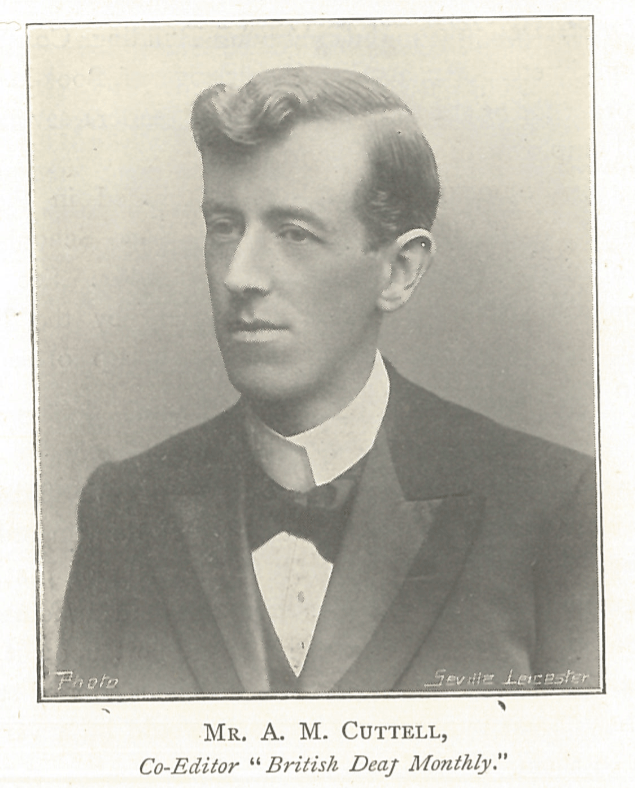 The Late Arthur Macdonald Cuttell, BDT 1905 p.41-2
The Late Arthur Macdonald Cuttell, BDT 1905 p.41-2
1899 National Association of Teachers of the Deaf, Proceedings of the Biennial Conference
Proposed Council of Ministers, BDT 1905 p.219
1901 Census – Class: RG13; Piece: 3004; Folio: 113; Page: 16
By H Dominic W Stiles, on 1 February 2019
 Joseph Bradley Foster (1863-1940) was born in Edinburgh, son of Joseph Foster, a ‘commercial agent,’ and Emily Ann Foster. There were at least eight children. When he was about eighteen months old, “he became deaf due to a severe shock to his nervous system” (quoted in Our Monthly Church Messenger to the Deaf, 1894 p.109-10, which I follow closely, along with the BDT article). Note how the author says ‘became deaf,’ rather than ‘lost his hearing,’ which is a subtle but interesting difference.
Joseph Bradley Foster (1863-1940) was born in Edinburgh, son of Joseph Foster, a ‘commercial agent,’ and Emily Ann Foster. There were at least eight children. When he was about eighteen months old, “he became deaf due to a severe shock to his nervous system” (quoted in Our Monthly Church Messenger to the Deaf, 1894 p.109-10, which I follow closely, along with the BDT article). Note how the author says ‘became deaf,’ rather than ‘lost his hearing,’ which is a subtle but interesting difference.
When he was five, his family moved to Glasgow. We are told that from there he was sent to New Barnet and London, to be educated by Mr. Van Asch, the teacher who was the first to introduce the German or Oral system of education (ibid, & British Deaf Times 1934, p.29). He remained with Van Asch for about six years or four years, depending on the two articles and presumably his memory when interviewed, and then attended an academy for hearing pupils in Glasgow. He was considered one of Van Asch’s best pupils (British Deaf Times).
He became apprenticed aged 16 (1879/80) to a Glasgow printer or ‘Lithographic Artist,’ as it says on the 1881 census. At that time (and in 1891) the family lived in No 32 Queen Square, Kinning Park, which looks to be a pretty row of stone houses in the Govan area. Attending local Deaf social gatherings it seems that Joseph then came across sign language for the first time. He joined eagerly in with the mission as an assistant to James Muir, and learnt sign language. Gradually the mission work became more important to him, and he was appointed missioner in North and East Lancashire in 1892, before moving on to Carlisle.
The article tells us that he could
articulate very plainly, and is a skilful lipreader. Through Mr. Henderson, of Glasgow, his views on the utility of the Oral system were laid before the Royal Commission, and, from his own perspective, Mr. Foster showed very clearly that, although it was in many cases a most useful accomplishment, it was of comparatively little value to the deaf in general.
On the 6th of September, 1899, Foster married a Deaf lady, Bessie Wolfenden (1873-1904), daughter of a brewer/’hotel proprietor’ (publican), Robert Wolfenden. Bessie was being boarded out when she was seven, with her brother and two sisters. At the time of her marriage she was living in Dale Street, Lancaster, while Joseph’s address was in Carlisle. Perhaps they had met some years before, when he was the local missioner? In 1901, when they were in Rickergate, Carlisle, they had a daughter, Gertrude B. Foster, two months old at the time of the census. Joseph and Bessie are both described as ‘Deaf’ but they had servants, including one who was ‘Deaf and Dumb,’ Mary Ostell, born in Whitehaven in 1879. Mary’s mother Annie Ostell (b.ca 1854) was also ‘Deaf and Dumb’ according to the 1881 census. The 1911 census does not say Annie Ostell was Deaf, but does say her eighteen year old lodger, Thomas Cunnings, was. ‘Deaf and Dumb.’ Was the 1881 record meant to say deaf after Mary’s name? There is clearing an interesting web of connections for someone to explore.
Sadly, Bessie died only a few years later, in 1904.
Foster later worked as a missioner in Leicester (1905-12/13), Oxford (1912/13-18), where he gave Selwyn Oxley ‘some insight into mission work,’ Gloucester (1918-23) and Exeter, where his assistant Mr. Dodds was headmaster at the Deaf School. In the 1939 Register he was living in retirement in with his sister Lilian and daughter Gertrude. He died in 1940 it seems, in Honiton.*
 *unless I have the wrong J.B. Foster
*unless I have the wrong J.B. Foster
Our Monthly Church Messenger to the Deaf, 1894 p.109-10
Retirement of Mr J.B. Foster. British Deaf Times, 1934, Mar-Apr, 29-30
Census 1881 Scotland – Parish: Glasgow Kinning Park; ED: 35; Page: 11; Line: 3; Roll: cssct1881_251
Census 1891 Scotland – Parish: Glasgow Govan; ED: 35; Page: 10; Line: 8; Roll: CSSCT1891_298
1901 Census – Class: RG13; Piece: 4867; Folio: 165; Page: 34
1911 Census – Class: RG14; Piece: 19314
Bessie Wolfenden
1881 Census – Class: RG11; Piece: 4270; Folio: 64; Page: 10; GSU roll: 1342021
1891 Census – Class: RG12; Piece: 3466; Folio: 42A; Page: 31
Mary and Annie Ostell
1881 Census – Class: RG11; Piece: 5160; Folio: 35; Page: 6; GSU roll: 1342245
1911 Census – Class: RG14; Piece: 31307